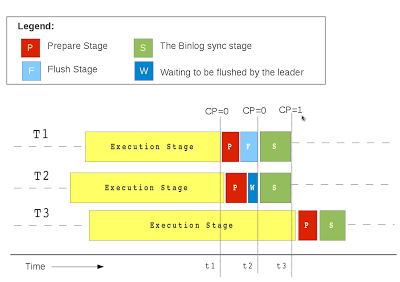MySQL 5.7: Enhanced Multi-threaded slaves
http://geek.rohitkalhans.com/2013/09/enhancedMTS-deepdive.html 科学上网
Introduction
The infamous out of order commit problem
On Master we apply T1 and T2 in that order.
State0: x= 1, y= 1 T2: { y:= Read(x);
|
On the slave however these two transactions commit out of order (Say T2 and then T1).
State0: x= 1, y= 1 T1: { x:= Read(y);
|
As we see above the final state state 2 is different in the two cases. Needless to say that we need to control the transactions that can execute in parallel.
Controlled parallelization
The process of committing: On the slave we need to make sure that the transactions that we schedule for parallel execution will be the one which do not have conflicting read and write set. This is the only and the necessary requirement for the slave workers to work without conflicts. This also implies that if the transactions being executed in parallel do not have intersecting read and write sets, we don't care if they are committed out of order. Since MySQL uses lock based scheduling, all the transactions that have entered the prepared stage but not as yet committed will have disjoint read and write sets and hence can be executed in parallel.
Logical clock and commit parent
The pseudo code is as follows.

Another thing to note here is that the "group" of transactions that are being executed in parallel are not bounded by binlog commit group. There is a possibility that a transaction have entered the binlog prepare stage but could not make it to the current binlog group. Our approach takes care of such cases and makes sure that we relax the boundary of the group being executed in parallel on the slave.
Conclusion
This feature provides the great enhancement to the existing MySQL replication. To know more about the configuration options of this enhancement refer to this post.
This feature is available inMySQL 5.7.2 release. You can try it out and let us know the feedback.
About the author

Rohit Kalhans is a Software Development Engineer based out of Banglore India. His area of focus revolves around Row-based replication and Multi-threaded parallel slave. His interests include system programming, highly-available and scalable systems. In his free time, he plays guitar and piano and loves to write short stories and poems. More Information can be found on his homepage.
MySQL 5.7: Enhanced Multi-threaded slaves的更多相关文章
- MySQL复制配置(多主一从)
复制多主一从 replicaion 原理 复制有三个步骤:(分为三个线程 slave:io线程 sql线程 master:io线程) 1.master将改变记录到二进制日志(binary log)中( ...
- MySql集群FAQ----mysql主从配置与集群区别、集群中需要多少台计算机呢?为什么? 等
抽取一部分显示在这里,如下, What's the difference in using Clustervs using replication? 在复制系统中,一个MySQL主服务器会更新一个或多 ...
- MySQL数据很大的时候
众所周知,mysql在数据量很大的时候查询的效率是很低的,因为假如你需要 OFFSET 100000 LIMIT 5 这样的数据,数据库就需要跳过前100000条数据,才能返回给你你需要的5条数据.由 ...
- mysql 2006
1.在my.ini文件中添加或者修改以下两个变量:wait_timeout=2880000interactive_timeout = 2880000 关于两个变量的具体说明可以google或者看官方手 ...
- MySQL高可用架构:mysql+keepalived实现
系统环境及架构 #主机名 系统版本 mysql版本 ip地址 mysqlMaster <a href="https://www.linuxprobe.com/" title= ...
- MySQL之备份
MySQL备份和备份 备份/还原 冷备:需要停止当前正在运行mysqld,然后直接拷贝或打包数据文件. 半热备:mysqldump+binlog --适合数据量比较小的应用 在线热备:AB复制 --实 ...
- linux MySql 的主从复制部署
MySql 复制 mysql 复制:将某一台主机上的 Mysql 数据复制到其它主机(slaves)上,并重新执行一遍从而实现 当前主机上的 mysql 数据与(master)主机上数据保持一致的过程 ...
- java面试一日一题:讲对mysql的MVCC的理解
问题:请讲下对mysql中MVCC的理解 分析:这个问题要回答的是对MVCC的理解,以及MVCC解决了什么问题这几个方面入手. 回答要点: 主要从以下几点去考虑, 1.什么是MVCC? 2.MVCC用 ...
- BlackArch-Tools
BlackArch-Tools 简介 安装在ArchLinux之上添加存储库从blackarch存储库安装工具替代安装方法BlackArch Linux Complete Tools List 简介 ...
随机推荐
- Chrome的网络调试
F12 然后
- ios游戏开发--cocos2d学习(2)
在第一节中简单介绍了2d项目模板HelloWorld的基础代码,并做了一点小小的改变,像触摸接收.旋转.移动和颜色转变序列CCSequence的使用等等,2d本身封装好了很多方便使用的动作,只需要调用 ...
- 你今天Python了吗?(下)
在体验了wxPython的强大之后,让我们把注意力集中到Twisted上来.在C++的世界里,你会发现一个很棒的网络应用框架,那就是ACE了:在Python的地盘,Twisted则是在网络应用框架中当 ...
- bzoj 2751 [HAOI2012]容易题(easy)(数学)
[题目链接] http://www.lydsy.com/JudgeOnline/problem.php?id=2751 [题意] m个位置,已知每个位置的可能取值,问所有可能情况的每个位置的乘积的和. ...
- ubuntu java jdk安装及环境变量设置
1.下载jdk1.7.0_79 (32位操作系统)jdk-7u79-linux-i586.tar.gz (64位操作系统)jdk-7u79-linux-x64.tar.gz http://www.or ...
- linux高级数据存储
linux内此存储模式由5部分组成,自低向上的顺序: 物理卷,内核块设备驱动,内核文件系统驱动,虚拟文件系统,应用程序数据结构; 系统中所有的文件仅按此模式存储,无论是数据还是元数据,均在此模式下统一 ...
- notepad++汉字突然横过来了
修改notepad++,汉字突然横过来了,如图, 百度了一下,原来是因为选择的字体"@微软雅黑"前面的@符号惹的祸,改成"微软雅黑"就没事了.
- work8
使用裸指针: #include <iostream>#include <memory>#include <stdio.h>#include <cstring& ...
- Hibernate关联关系之——单向n-1
1 .单向 n-1 关联只需从n的一端可以访问1的一端 2.域模型: 从Order到Customer的多对一单向关联需要在Order类中定义一个Customer属性,而在Customer类中无需定义存 ...
- Hive自定义UDAF详解
遇到一个Hive需求:有A.B.C三列,按A列进行聚合,求出C列聚合后的最小值和最大值各自对应的B列值.这个需求用hql和内建函数也可完成,但是比较繁琐,会解析成几个MR进行执行,如果自定义UDAF便 ...
